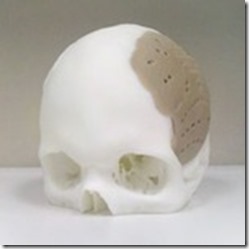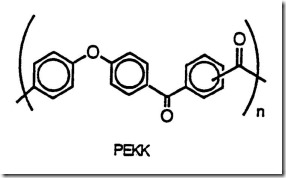Guest Post by Steve Erickson
 Recently, an elderly woman was the recipient of the first 3D-printed body part: a lower jaw replacement. Soon after, an American man made headlines for being one of the first recipients of a 3D-printed medical implant, with 75% of his skull replaced with a custom-made, printed implant. These stories hint at what is to come. With 3D printing of medical implants on the rise, the medical world is undergoing a huge transformation.
Recently, an elderly woman was the recipient of the first 3D-printed body part: a lower jaw replacement. Soon after, an American man made headlines for being one of the first recipients of a 3D-printed medical implant, with 75% of his skull replaced with a custom-made, printed implant. These stories hint at what is to come. With 3D printing of medical implants on the rise, the medical world is undergoing a huge transformation.
While some implants, such as hearing aids, have been 3D-printed for several years, you can expect to see much more custom printing for a wider range of applications in the future.
Uses
The advent of 3D printing will have the most immediate impact in the orthopedic and dental fields, but with further research, it will be adopted by other specialties. Current and future applications include:
- Orthopedic implants, which are made of titanium and/or polymers; over time, the replacement of larger amounts of bone will become possible
- Dental implants, such as crowns, bridges, caps, and even roots
- Hearing aids
- Visual models and surgical guides, which help physicians perform more effective, individualized surgery
- Soft tissue and organs have not yet been 3D-printed but are a current focus of research
- Printed veins and arteries could revolutionize heart surgery and other major procedures
In addition to higher levels of customization and a wider range of applications, 3D printing of medical implants will work in tandem with existing body parts. For example, in the future, bone implants may utilize fabricated structures that serve as scaffolds to stimulate existing bone to grow.
Benefits of 3D Printing
The 3D printing of medical implants has great advantages compared to traditional treatments. 3D-printed implants can:
- Use polymers that are chemically similar to the tissues being replaced
- Be precisely customized for each person’s body, an important factor with all medical implants
- Lower costs for both the patient and the healthcare provider
- Lower the level of toxicity in implants
- Be produced more quickly than traditional custom-made implants
Polymers
The use of polymers is revolutionizing medical implant technology and 3D printing. One company, Oxford Performance Materials (OPM) produces “OsteoFab™,” a patient-specific cranial device (OPSCD). OsteoFabs are additively manufactured (another term for 3D-printed) medical and implant parts produced from poly(ether-ketone-ketone) or PEKK, an ultra-high-performance polymer used in biomedical implants and other highly demanding applications.
PEKK polymers are unique in that they are biocompatible, mechanically similar to bone, and radiolucent so as not to interfere with x-ray equipment. With OPM’s manufacturing process, implants are “grown” layer by layer, directly from a digital CAD file without the aid of tooling and with few limits on what can be produced. OsteoFab™ technology is great for one-off implants shaped to each patient’s anatomy. An ideal use for OsteoFab™ implants is for cranial bone to replace parts of the skull damaged by trauma or disease.
How does additive processing work with PEKK? Using a needle and molten PEKK, layers are deposited using a CAD file to sequentially build up the structure. As the layers are deposited, the structure begins to take shape.
In the future, 3D printing of soft tissue may reduce or eliminate the need for donor tissue and organs, meaning more patients will receive treatment without the complications and life-long medications associated with organ donation today. The technology isn’t here yet, but future developments could eliminate the wait for donor organs.
The Bottom Line
3D printing is already making waves in the medical world, but the biggest advances are yet to come. Currently, orthopedics, audiology, and dentistry are being transformed by the availability of 3D printing. In time, the treatment of diseased organs may be revolutionized as well.
About the author:
Steve Erickson, Vice President, Sales & Engineering, brings more than 30 years of experience in the plastic injection molding industry to First American Plastic Molding Enterprise and Quad, Inc., both in South Beloit, IL. First American Plastic Molding Enterprise is a custom plastic injection molding manufacturer and assembler for the automotive, food, medical, and industrial markets.


Working in the forefront of 3d printing, we are very excited to see where medical printing is or might be heading with various polymers and designs.
I’ll need a cap replacement for a tooth in the near future, maybe the next one will be a result of a printed design or mold.
this new printing technology could revolutionize the process of manufacturing for prosthesis. Also, the technology has a great impact in build complex parts for robot
3D Printing is really very beneficial for us. Overall that was really awesome post. Thanks for sharing such informative post. Jeff.
3D printing is a fascinating technology and has a great advantage in the medical and dental fields. It is being widely utilized nowadays.
Yeah, printing technology has advance techniques through which we can do or generate something new to world. In medical world I think 3D printing can play a major role and makes easy way for medical. The benefits of 3D printing that you shared with us are really amazing. I feel glad to read this article.